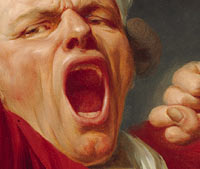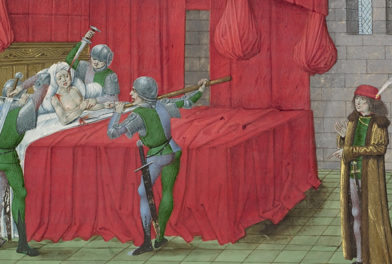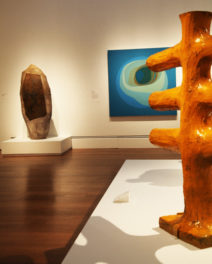
Self-Portrait, Yawning, Joseph Ducreux, before 1783. Oil on canvas, 45 x 35 in.
Nowadays, seeing a silly picture of a person is hardly unusual. Showing personality is a good thing.
Social customs weren’t quite the same in 18th-century France, when Joseph Ducreux painted this self-portrait. An official court painter, he was known for refined portraits of important figures such as Marie Antoinette. But he also created unusual depictions of himself in various emotional states.
The traditional portrait shows a subject at his or her primped and composed best: look at Goya’s commanding marquesa, Cézanne’s intellectual journalist, even Warhol’s Self-Portrait in Drag. Yet here we see the artist at his most informal, examining his own yawning face and gestures.

Does this portrait make you laugh? Yawn? Ponder the human body and psyche?
Does art have to be serious? If you were having your portrait done, would you prefer a traditional portrait—or a more offbeat one, like this?
Question of the Week is a series inspired by our Masterpiece of the Week tours, offered daily at 4:00 p.m. Featuring an open and upbeat discussion among visitors and gallery teachers, the tours feature a new object and pose a new question each week.




I love this painting because it’s full of contradictions: it’s “low” art because it’s like caricature, but “high” art because it’s got the Old Master’s complete full bag of tricks, including amazing foreshortening, sense of motion, skin tones, shading…It’s also both unflattering and flattering at the same time — unflattering for his physical appearance (that belly! that huge open mouth!), but flattering to his artistic abilities — almost like he’s daring us to be shallow enough to judge him on his looks alone.
Hi Christiana,
I very much share your sentiments. Ducreux is playing a game with his audience at this point, where it feels like he wants us to appreciate his skill as an artist through this unconventional depiction of himself. He is not afraid to experiment with the way that he portrays himself and is also fearless with respect to his public reception.
I think this portrait is fabulous. And I would most definitely prefer an offbeat one of myself. Personality portraiture is the best kind.
Hi Danielle,
Thanks for your thoughts! I’d also prefer a more unusual portrait, if it is done well.
This is such a fun portrait. You can see where it could be an exercise in musculature, foreshortening, and rendering various values of the same fabric as well as being a statement that this artist did not take himself too seriously. Being older, and a wee bit more vain/sensitive about my appearance, I would have to fall into a more idealized mode if I were to have a portrait painted. Not necessarily serious, but certainly better than my day to day appearance. This is why Photoshop is my friend when it comes to photos…
It is a fun portrait, and as you pointed out it is definitely an exercise in how deftly the artist can capture his momentary expression. It’s interesting to think about his actual process, with paintbrush in hand and easel next to him. Most likely he had to make this yawning pose many times in a mirror in order to reimagine it on canvas. I think that although this pose appears silly, there is a lot of serious intent underneath, namely him wanting to impress the art establishment of the day with his skills at depicting emotional states or as they were called “expressive faces”. We know that he made three attempts to be admitted to the French Royal Academy, all without success and instead, exhibited his work outside of the officially sanctioned Salons. But, he continued his passion for his irreverent self-portraits and made dozens of them throughout his career.
I have always loved this painting! It makes me smile (and yawn) whenever I see it, and I think it’s obvious from the freshness of the brushwork and the freedom Ducreux used in his off-center composition that he was enjoying himself immensely. The fact that he could also indulge in a type of portrait that would NOT have been accepted by the art establishment or the wealthy patrons who demanded perfection (even when it had to be invented!) – well, this must have been a terrific source of relaxation and fun for the artist. In addition, these portraits helped him to flex his skills – examine the human face in new perspectives and study the musculature and structure of the face in detail – all skills which he put to great use in his refined, elegant and restrained formal portraits.
Paintings of people doing “silly” things, or making faces, or simply laughing out loud (and in “The Laughing Cavalier” by Hals, you truly CAN almost hear the ringing laugh of the jolly fellow, no?)- these paintings expand our understanding of our own humanity. And isn’t that what all art is supposed to do? I would venture to say so. Art depicts the great moments and the small moments; the tragedies and the comedies; the stately and the silly.
So yes – indeed. Producing laughter in the viewer is as much a part of great art as moving the viewer to tears. What a wonderful discussion topic based on a wonderful painting! Thank you!
I actually don’t see anything funny in this painting and in this pose. If anything it reminds me one of Goya’s Caprichos. It shows a person in a state of bitterness and desperation, and even makes me think that this buffoonery an expression of social protest. I don’t want to automatically label him Jacobin, but it is conceivable to suspect him in sympathizing.
Hi Michael,
Thanks for sharing your feelings about Ducreux’s expression. Although timewise, it doesn’t quite coincide with Goya’s work on the Caprichos, I do see how you can get an uneasy feeling from this portrait. Ducreux is showing us a grotesque side of himself and because we don’t have a letter from the artist testifying his feelings, we could read it in many personal ways. As for him being a Jacobin or a sympathizer, I have to agree with Derek that it was too early to tell at that stage. There is, however, some interesting information about Ducreux’s later life that I am happy to share. We know that he was a court painter to Marie Antoinette and created a variety of court portraiture including Louis XVI’s last portrait, made on the day of his execution as well as a portrait of Robespierre. He fled to London in 1791, as the French Revolution was getting more radical and consequently returned to Paris in 1793. Despite his connection to the previous regime, his friendship with Jacques Louis David (who was a Jacobin and a painter of the Revolution and consequently Napoleon’s court painter) enabled him to continue his career. His affiliation with David allowed Ducreux to take up residence in the Louvre from 1793 to 1797, where the two artists also worked in adjacent studios.
Michael: that seems a stretch. Certainly Ducreux was not thinking of Goya when he composed this image, and he could hardly have been a Jacobin (or a sympathizer) prior to 1783. He couldn’t have been a Jacobin (or sympathizer) prior to 1789. Bitterness? Desperation? He looks like a contented child.
I believe that a great portrait will capture the personality and essence of the subject; so a portrait of myself that would give me pleasure to look at, would be serious in intent, but could capture me in a silly moment as long as it is authentic. I do own a portrait of myself, done by a good friend who completely captured the photo that she worked with – but it makes me self conscious to look at because it was posed – and yet, it puts me in a more attractive light than when I am caught off guard in photos, where inevitably I look like a geek.
Does this painting make me laugh or yawn? No and no. But I love its line and colour tones and sense of irreverance.
I don’t have the time right now to thoroughly explain what I mean, and I will do this when I will have a chance. For now please take a look at this superimposed picture.
http://i79.photobucket.com/albums/j132/mgaft1/Superimposed.jpg
Cheers
Let me first discuss what I meant by sympathizing with Jacobins. Surely at the time when he made the portrait, the term itself hasn’t been coined yet. However, I think the Jacobin ideas were already brewed. French revolution didn’t just happened by accident. In a way it was an application of the ideas of Enlightenment that spun out of control and by 1783 ideas of Enlightenment were developed and well defined. Surely Decreux had the reasons to be thankful to French court that employed him.
Yet as an artist he couldn’t but see the state of the affairs in France and be in tune of what went on in minds of artists and intellectual of the time. The fact that he had to paint “big cheeses” in a very proper, classical way, could, conceivably, add to that inner turmoil, contradiction and torments that Decreux might feel. Goya was also a court painter, and was financially dependent on aristocracy. Yet he painted his famous “Family of Carlos IV,” that contemporaries considered as insult to realism. Decreux probably also used his self portrait as escape or some sort of a protest, a way to counterbalance his regular “goody to shoe” paintings with grotesque. It’s like he was saying “Here’s for you, bastards!” LOL
His fleeing to London in 1991 doesn’t really prove his royalist conservative views. Sympathizing or not he could easily be guillotined simply because of his association with the court. There were many cases during the Russian revolution, for instance, when people’s fate was decided simply by quick examination of calluses of their hands: existence of which meant life and absence means an immediate death. I think that Jacobins could have been just as quick and thorough in their decision making.
More so it was one thing for an intellectual and artist to think “protest” and be not happy with the state of affairs theoretically and a totally different one to see actual blood, deaths and decapitations. In that sense Decreux was probably a more sincere person that David, who basically a changed his political views every times new regime came to power.
The truth is – I don’t know much about Decreux’s and the little bit I found on line didn’t shed the light at his personality. But simply, observing the portrait doesn’t make me think of happiness and “clean fun.” If anything Decreux didn’t depict just some accidental yawn – his eyes are not sleepy and he doesn’t looks tired or simply stretching after sitting in cramped position for a long time. This pose and yawn are deliberate and directed to someone. It’s like a yawn meant as an insult, a challenge or contempt. It’s like Decreuxis telling someone “I am so bored of listening.”
i was actually tired when i saw this, he is not only yawning, we both were yawning.